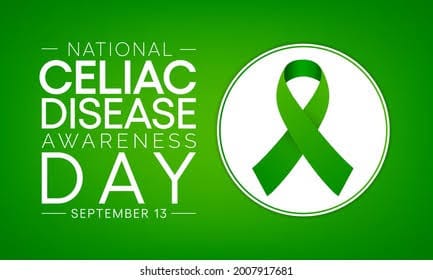National Celiac Disease Awareness Day – September 13, 2022, history, quotes, FAQS
National Celiac Disease Awareness Day, every September 13, is a good time to examine this little-known disease that affects about 3 million Americans. Celiac disease is a genetic autoimmune disorder in which a person who suffers from this affliction can’t consume gluten, a protein found in wheat, rye and barley.
The afflicted person’s immune system responds by attacking the small intestine and inhibiting the absorption of important nutrients. Left undiagnosed or untreated, celiac disease can lead to other disorders, including cancer, osteoporosis and infertility. This year, on National Celiac Disease Awareness Day, learn a little more and share what you learn.
History Of National Celiac Disease Awareness Day

National Celiac Disease Awareness Day was developed by the United States Senate to raise awareness of this condition, stating in their resolution that we all “should become more informed and aware of celiac disease.” Celiac disease was first discovered by Samuel Gee in 1888, a pediatrician who recognized that the symptoms he was observing were all tied to the diet of his patients.
In honor of this man and the lives that he has helped to make better through awareness and education about this disease, his birthday was selected as the yearly celebration for National Celiac Disease Awareness Day.
Celiac disease affects the lower intestine and occurs in those who have a genetic predisposition to the condition. The disease is a result as part of a reaction to gluten, a protein found primarily in grains like barley, wheat, and rye.
It is most common among those aged six months to two years, and in these patients can cause serious issues due to poor nutrient absorption, often causing anemia. For all sufferers of Celiac disease, the only treatment is a lifelong diet free from gluten.
NATIONAL CELIAC DISEASE AWARENESS DAY TIMELINE
AD 100
Celiac disease is diagnosed
Greek physician, Aretaeus, gives one of the first descriptions of celiac disease, which the doctor calls,” koiliakos,” an abdominal infection.
1908
Celiac and children
American physician, Christian Herter, publishes a book on children afflicted with what he dubs “intestinal infantilism.”
1952
Researchers celebrate a breakthrough
Scientists in Birmingham, England, link celiac disease with gluten for the first time.
HOW TO OBSERVE NATIONAL CELIAC DISEASE AWARENESS DAY
Try a gluten-free diet
Some people — unaware of their own sensitivity to gluten — find that they feel much better when they stop eating foods containing the protein. As more information comes out about celiac disease, more people will make life-changing decisions to lead gluten-free lives.
Learn where gluten hides
Foods like soups, salad dressings and soy sauce can unexpectedly contain gluten. If you’re eating out, don’t be afraid to ask if a food contains gluten.
Reading food labels
This is always good advice, whether you’re suffering from celiac disease or not. One of the best ways to monitor our health is to monitor what we put in our bodies.
5 LIFE-SAVING FACTS TO KNOW ABOUT CELIAC DISEASE
Who gets it?
Celiac disease is more common in Caucasians, women, people with Down syndrome, and patients with type 1 diabetes.
Gluten sensitivity and celiac disease are different
People with gluten sensitivity may experience bloating and diarrhea — but only people with celiac disease have compromised immune systems as a result of this disease.
The numbers are rising
The number of Americans with celiac disease is increasing — possibly due to increased awareness and better diagnostic techniques.
Childhood symptoms
Digestive symptoms are more common in infants and children. These include abdominal pain, diarrhea, vomiting, and constipation.
Adult symptoms
The list is fairly long: watch for (among other symptoms) unexplained iron-deficiency anemia, fatigue, bone or joint pain, arthritis, osteoporosis or osteopenia (bone loss), liver disorders and depression.
WHY NATIONAL CELIAC DISEASE DAY IS IMPORTANT
It helps researchers follow and record undiagnosed cases
The University of Chicago Celiac Disease Center estimates that about 97 percent of celiac cases go undiagnosed in the U.S., leaving many people to suffer needlessly.
It leads to questions — and hopefully, answers
It’s the perfect time to ask questions about our overall health, especially since so many people are unaware that celiac disease can affect parts of the body that seem unrelated to the digestive system (e.g., skin rash, joint pain).
It may affect you or someone you know
Celiac disease reportedly affects one percent of all Americans, so this observance can help spread valuable information. Spread the word!
How To Celebrate National Celiac Disease Awareness Day
The best way to celebrate National Celiac Disease Awareness Day is by developing an understanding of how to prepare gluten-free foods. 1 out of every 100 people on Earth are thought to suffer from some degree of this disease, so it’s likely that someone in your friends or family would be grateful for another person who understands their needs. There’s nothing better for someone who suffers from Celiac than being able to be presented with a special meal they can enjoy without reservation. National Celiac Disease Awareness Day is your opportunity to learn a little more about the lives of those who live with Celiac.
Sandeep Raiza — Content Writer, Website Designer, SEO Strategist, and WordPress Expert AI specialist delivering impactful digital solutions that drive business growth.Combining creative storytelling with technical expertise.




